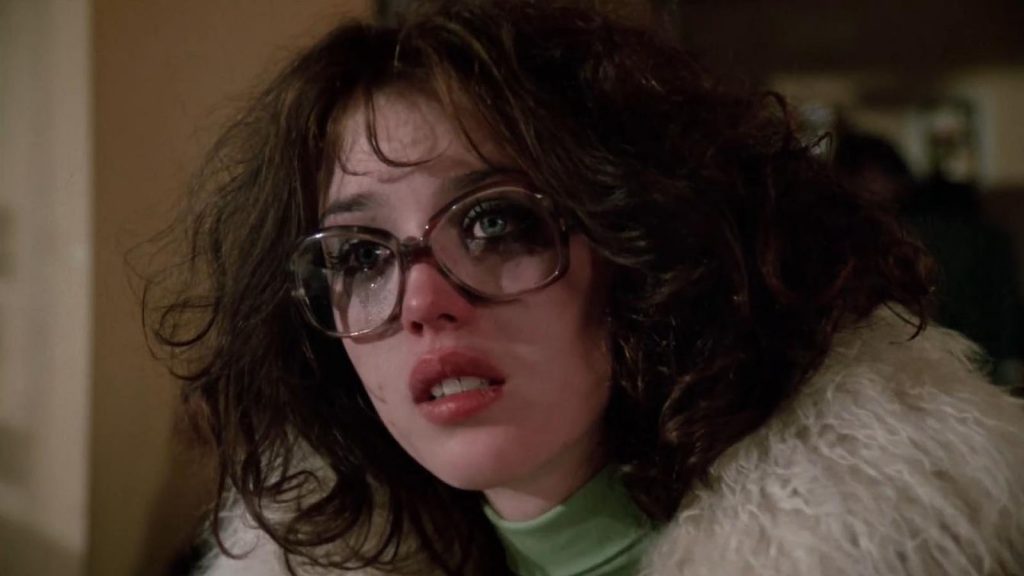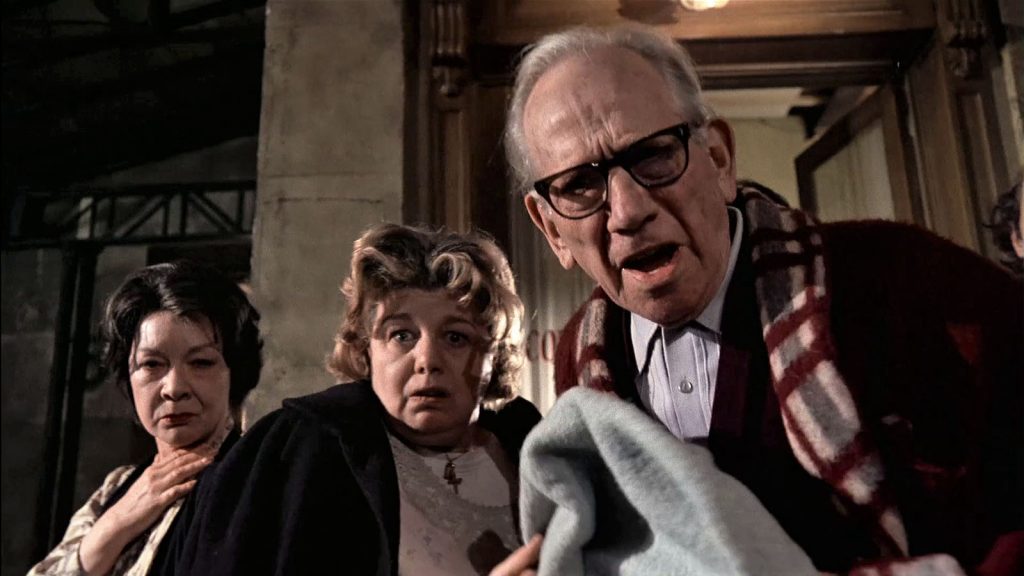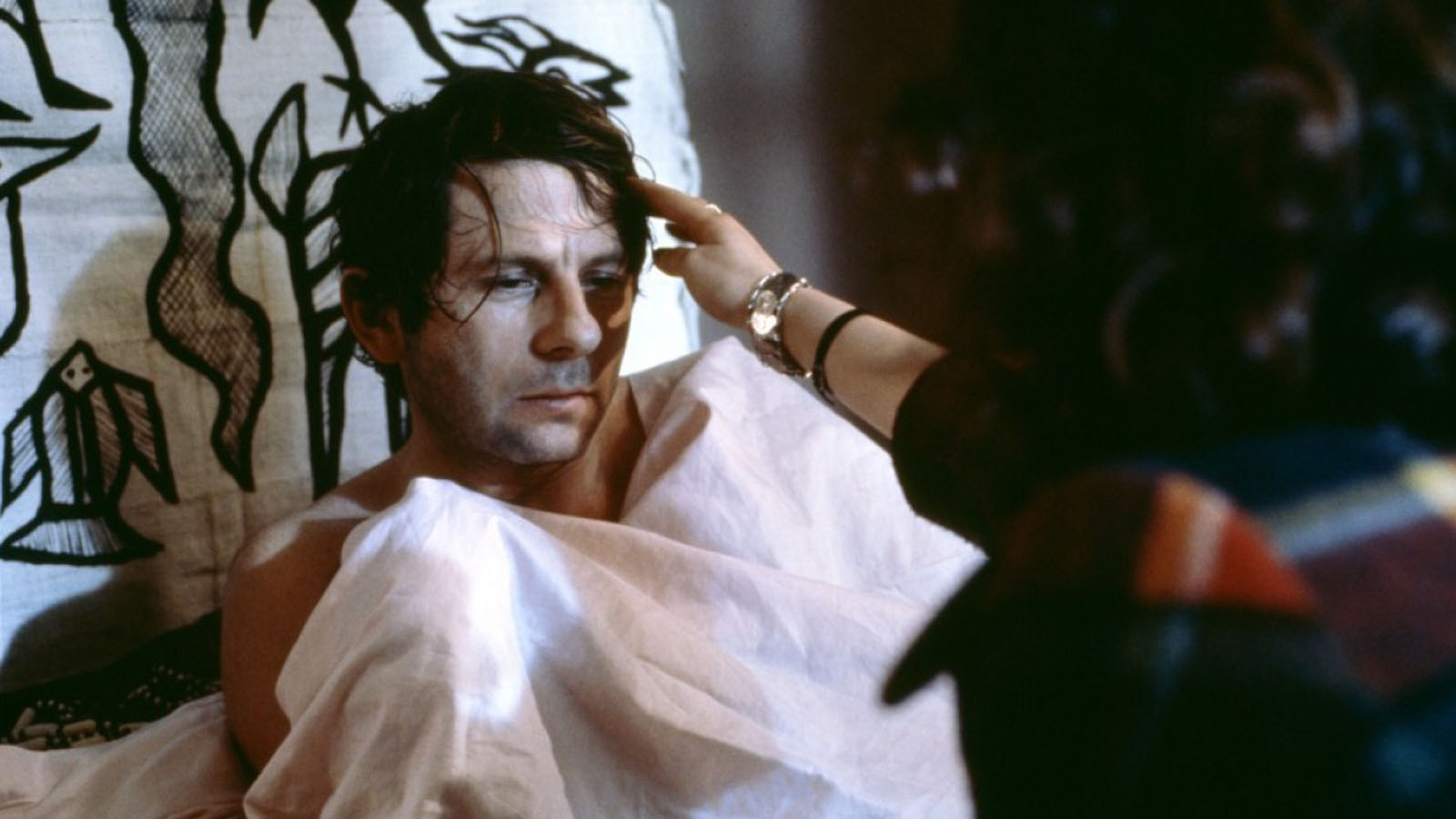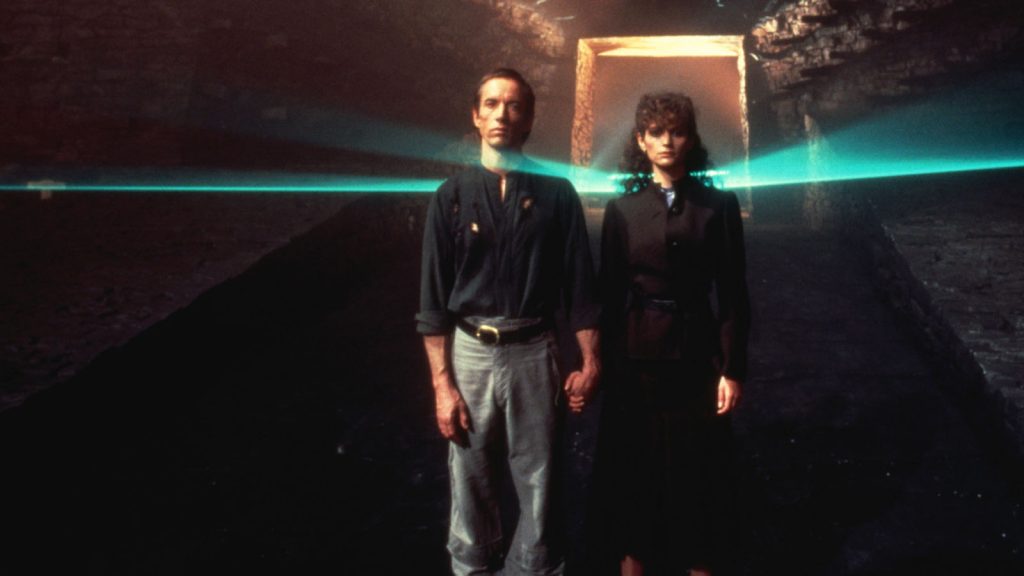There is nothing quite so destabilizing as being told again and again that you are someone you are not.
In The Tenant (1976), a foreign man moves into the apartment of a woman who recently tried to commit suicide. Trelkovsky (we never learn his full name) obtains the flat by sketchy means shortly before she dies in the hospital. After moving in, he either enters into a paranoid spiral haunted by the idea of the dead woman, or he is, through manipulation and supernatural means, being transformed into “Simone Choule.” Neither reading feels 100 percent true, and unlike the other films in Roman Polanski’s unofficial Apartment Trilogy—Repulsion (1965) and Rosemary’s Baby (1968)—we never quite find out if the protagonist here is driven to madness, following the previous tenant headfirst out of the third-story window, or if he has simply lost his mind.
The thing about the Apartment Trilogy is that the films contain very female anxieties, very female neuroses. Everyone is looking at you, everyone is controlling you, everyone is listening, everyone is “yes, dear”–ing you to death. There’s the fear of being touched. Fear of doctors. Fear of men. Dissociation from your body or your surroundings. Agoraphobia. Insomnia. Developing an eating disorder. Thinking you are being driven to something (human sacrifice, murder, suicide) by the people in your life, both major and minor. Those strolling by the dull, gray Paris winter streets are in on it, too. Everyone is in on it. Everyone except you.
The Tenant often feels like an autocritique, or an inversion, in which the female paranoid experience is visited upon an unsuspecting random who just walked in off the street. In a very Harold Pinter touch, Trelkovsky reeks of an unspoken guilt that hounds him. Then he starts acting out. Unlike with Mia Farrow’s Rosemary Woodhouse, we are shown several times that Trelkovsky is hallucinating things that aren’t happening. He’s also a shitty person in an extremely male way. He tries to sleep with Simone’s messy but sophisticated friend Stella (Isabelle Adjani) before the former occupant is even dead. He compulsively lies about trivialities, worried and ashamed of things no one would ever care about.

Trelkovsky surreptitiously attends Simone’s funeral and has a sudden panic attack. The priest’s words twist into a hateful, incoherent accusation, and Trelkovsky runs from it. The walls begin closing in at home as people start banging on the ceiling for every little noise, his apartment is ransacked; the landlord and concierge quibble with him over every minor disruption. Each time he goes to buy coffee or cigarettes, the shop around the corner accidentally serves him Simone’s preferences.
Then he finds a tooth wrapped in cotton buried in the drywall behind an armoire. Before long, he has barricaded himself in his room, from which he stares down at the courtyard where his neighbors bind and prod the other disruptors: a meek, old woman and her disabled daughter. He watches the building’s sinister occupants bounce a severed head like a ball. He wakes up dressed in Simone’s clothes. He wakes up missing a tooth. He also seems to be losing it emotionally—slapping a child in public, screaming at a café waiter. Following the implied violence of a heroine walking helplessly into traffic in the previous two Apartment films, Trelkovsky steps off a curb and is immediately hit by a car.
Polanski’s eternal contradiction is shared by many of the men in his generation or peer group: he is a misogynist who makes amazing art about women.
Rarely has a movie felt more loaded with bad vibes—in both its historical context and content—than The Tenant. If Rosemary’s Baby is considered a cursed film, this is a haunted one. The guilt leaking from the movie has never been equaled and is never truly explained. Polanski made the film shortly before his arrest for sexually assaulting a minor and his permanent self-exile to Europe to avoid jail time. This is often narrativized against the dual tragedies he had experienced—the butchering of his wife Sharon Tate and their unborn child by the Manson family in 1969, and having witnessed his parents being sent to death camps during the Holocaust. The Tenant’s co-writer Gérard Brach spent decades grappling with severe agoraphobia. Supporting child actor Eva Ionesco felt exploited by her famous photographer mother, who shot erotic portraits of her as a minor, and she spent most of her adulthood taking her mother to court for restitution.
This happens in the film, too—humiliations and awkward silences are played for dry humor but also horror. Trelkovsky is humiliated, often. Yet the cruelest thing of all happens to someone else—a drunk walks into a bar and buys the whole room a round, then points at a sobbing sad sack and says, “Except for him.”

There is an implication that a curse is somehow at play. The grieving sad sack sends the dead woman a postcard from the Egyptian wing of the Louvre. The community restroom on Trelkovsky’s floor is carved deep with impossible hieroglyphics. We see the dead woman unwrap herself from head-to-toe bandages, standing in that restroom, grinning at Trelkovsky from across the courtyard. The empty space at the inside of The Tenant is a Mummy’s curse. It never becomes a Hammer horror film.
The film’s purview is literary as opposed to cinematic. An earlier version of the script was developed by playwright Edward Albee. Polanski’s co-screenwriter Brach was the director’s own fakebook for 19th- and 20th-century fiction. He could be Pinter (Cul-de-sac), he could be Bataille (Bitter Moon), he could be Robbe-Grillet (Frantic), he could be Le Fanu (The Fearless Vampire Killers). In The Tenant, you can feel that their polestar is Kafka: the circling web of mild inconveniences that spiral into a kind of inescapable but polite hell recalls both The Castle and The Trial, down to the ferocious sexuality masked underneath the absurdity of dry manners.
Trelkovsky, played by Polanski himself, is a sniveling little shit. The director had wanted Robert Shaw for the role, probably due to his performance in William Friedkin’s 1968 Pinter adaptation of The Birthday Party… they didn’t get along. Something about Polanski is that he’s a contemptible twerp (he is DEFINITELY guilty, by the way, and belongs in prison), but he is fearless when it comes to adaptations. He once ascribed his Grand Guignol take on Macbeth to Shakespeare’s quality of being so “laconic” in his stage directions.
Trelkovsky is hounded by something unspoken, so his callous qualities keep poking out, and he blows every chance he has to sleep with Stella. People barely listen to his constant lies. He is consumed with appearances and decorum, implying that he’s tightly wound but also that he’s worried about a secondary set of rules that apply only to him. This paranoia has an additional bite to Trelkovsky’s Kafkaesque experience: it mirrors the unspoken, hidden rules Polanski experienced as a Jewish boy in Nazi-occupied Poland. But glibly reading The Tenant as a one-to-one autobiographical metaphor ignores how strange the film is, and in how many ways the paranoia can be interpreted.

Adjani’s performance as Stella is extremely physical—a Milo Manara girl dressed like a Diane Keaton character with a benzodiazepine addiction. It feels like her bee-stung lips never close throughout the film. She’s overwhelmed by grief, but not so much that she doesn’t want to grope a stranger when they go see Enter the Dragon. There is something mildly unnerving about even the dubbing. Adjani’s distinctive voice is missing, replaced with that of a generic-sounding woman. At one point, we see her post-shower, her hair down and gorgeous. In that second, she is almost a different person. Trelkovsky never closes the deal with Stella, talking his way out of sex with a drunken monologue about severing his own head. His dissociation from his very body is spoken aloud.
The upsetting thing about the recurring moments of being told he is a different person is that, after a while, it starts to work. Trelkovsky’s identity wasn’t particularly strong to begin with. He soon begins to define himself basically as “Not Simone.” How strong is your self-image? How strong is it really? How many blows can it take before you question your own conception of yourself? How much of your psychic territory do you cede to the world?
Every woman I have ever met describes their most paranoid self by alluding to either Rosemary Woodhouse or Carol from Repulsion. Very few mention The Tenant. Women in New York love to talk about holing up in their apartments like Catherine Deneuve. They rarely mention The Tenant. No one mentions The Tenant. I feel like all three movies resound with equal potency. All the entries in the Apartment Trilogy watch a person consumed by their fear of others, trapped in a cramped space that becomes increasingly inhospitable. All three films find ways to explore the body and the mind as fragile and permeable. No one ever mentions eating disorders in any of the installments, but they all depict them. Watching apartments rot, dragging furniture around at night.

The defining image I have of The Tenant is of Trelkovsky sitting deep in the frame, a lamp askew on the floor in the middle ground. He is draped a black floral dress and a wig, his hand bleeding from punching out his window. He takes off the wig and stares at the camera.
The Tenant is not a trans movie because it’s not a movie about transformation or discovering yourself, but it gets at some of the alienation aspects of transsexualism that few movies on the topic ever do. It’s not a movie about gender dysphoria. Trans movies—or movies read as trans—are often about transformation or the abject period at the beginning of a person’s transition. In rare cases, transness is depicted as (or an obsession with) an unattainable beauty, especially in the space of media representation. The Tenant depicts an aspect of my personal experience as a trans woman that I feel is unseemly to even recognize in a forum such as this.
One night, Trelkovsky leaps from his third-floor window and lives. He then drags his bloody, wounded body up the spiral staircase, screaming at his neighbors and spitting blood. All they can talk about is how crazy he is, what he’s wearing, and that they’d just finished repairing the roof. Eventually, this gives way to true horror. Trelkovsky’s neighbors silently realize he’s insane, his body is shattered. He says he won’t let them get away with it.
All he sees of them are forked-tongue demons. They have driven him to this. Haven’t they? Is he cursed? Was it the people? The building? The dead girl herself? Did he bring this upon himself somehow? Is there something different he could have done?

The connection between gender dysphoria and suicide is well-documented—and staggering. Suicidal ideation is part and parcel of the experience. It is a much larger common denominator for trans people than anything you would see in a movie, like learning how to socialize as the gender you identify with. Suicide is a rough topic for any film to address, especially when shown the way it is here. There is something particularly sinister about the end of The Tenant.
I don’t think Polanski has experienced overwhelming gender dysphoria; I don’t think this movie is about him exploring his own relationship to the opposite gender. But there is some shadow self in the story that finds parts of the gender transition often excluded from narratives because of how ugly they are.
There are aspects of transitioning that feel like phantom limb syndrome. The sense that you are missing time, missing parts of yourself, groping around in the blackness for something that must be there. I have woken up in a dark room in a dress, covered in my own blood, not knowing exactly how I ended up there. I have been suicidal. I have believed everyone, every single person in my life, was trying to kill me. To drive me to suicide. When I was institutionalized, I repeated “all of them witches” to myself as a little joke. Because this could not possibly be happening. Transitioning has saved my life, but I also think there is a part of me that hates the person I was and needs to annihilate that person—in public—to become myself. The Tenant finds that feeling in my body and slowly tightens around it until I am watching Trelkovsky hurl himself out a window to a cheering crowd.
Waking up in a dress, in your room, in the dark. Not knowing what hour it is or how you got the cut on your arm—what is a girl to do? 🩸

is a writer and filmmaker living in Brooklyn.
It’s so strange that Dario Argento’s 1996 movie called The Stendhal Syndrome is really about post-traumatic stress disorder when nearly all of his classics somehow involve Stendhal syndrome.
BY LAURA WYNNE | December 27, 2024
“Because you were home.” That’s it. The best home-invasion movie ever made is built on a foundation of senselessness. There are people in your house trying to kill you...
BY LAURA WYNNE | May 22, 2024
High-concept, no-frills horror is writer-director-editor-composer Andy Mitton’s modus operandi.
BY LAURA KERN | December 5, 2022

This pre-Code offering packs a lot of story into its typically brisk running time, with several plot threads weaving together a (not always successful) tapestry of spooky and criminal doings.
READ MORE >
BY ANN OLSSON | Month 00, 2021

In what could be the fastest-resulting rape revenge movie, a drunken lout brutally forces himself on Ida, the young woman who doesn't return his affections, during a party over Labor Day.
READ MORE >
BY LAURA KERN | Month 00, 2021

Beast is a lot of movies in one package - fractured fairy tale, belated-coming-of-age story, psychological drama, regional horror film - but above all it's a calling card for its leading lady, Jessie Buckley.
READ MORE >
BY LAURA KERN | Month 00, 2021